“There is a beautiful rock in the middle of Australia sometimes known as Ayers Rock, but now more commonly known by its traditional indigenous name, Uluru. The red rock that stands sensationally in the middle of Australia's red desert centre has been there for hundreds of millions of years, according to indigenous belief. The UNESCO World Heritage site is sacred to the Anangu people, the traditional Aboriginal landowners in this region.” Introduction to an article about a new dispute over tourists climbing the rock, triggered by the Chief Minister of the Northern Territory, Adam Giles, Australia’s first indigenous head of government.
Giles asked for people of the area to reject an impending total ban on climbing Uluru by the Australian government.
Here are some reasons why it is a good idea not to do the climb: It is a sacred indigenous site, mass tourism causes issues for cultural sites, Uluru is not a 'tourism product', you could die (37 people have), it is not the Sydney Harbour Bridge, not everything is about money.
Giles worried that banning the climb would reduce Uluru’s attraction to tourists. After "coincidentally" watching people climb the Sydney Harbour Bridge before visiting Uluru recently Giles noted that more than three million people have clambered up the steel structure since it opened to the public in 1998. Think if that could be Uluru, he thought. Genius.
The Nguraritja and Anangu people of the area don’t want visitors to climb Uluru. The Anangu, who have lived in the shadow on Uluru for thousands of years, are now based in the nearby appallingly poor Aboriginal community of Mutitjulu. They say that climbing the rock has caused them deep cultural offence and sadness for almost two decades.
Twenty-five-year-old Keshia Randall, whose family are traditional caretakers of Uluru, is disturbed by the number of climbers.
“I find it disrespectful, I’m frustrated that the national park isn’t shutting it down, they think that it’s the main attraction and tourists just want to come here to climb a big rock.”
Debate around closing the climb has raged since 1985, when the Uluru-Kata Tjuta National Park was handed back to the traditional owners by the then Labor prime minister, Bob Hawke. Shortly afterwards the land was handed back to the Commonwealth [national] government on a 99-year-lease.
Although the traditional owners have the majority on the management board of Uluru-Kata Tjuta, the climb remains open. Miss Randall, who previously worked for Parks Australia, believes that non-indigenous management are deceiving Anangu board members into keeping the climb open.
“I think they (park management) are convincing those on the board that if the climb closes, the tourist money will stop,” she says. Mutitjulu, a community where poverty is rife, relies heavily on royalties from the national park entrance fee.
The Anangu only climb Uluru for cultural reasons, including initiation. They say it’s not just the climbing that is causing problems. Human waste and urine left by climbers at the top are poisoning the water holes that pockmark the sandstone and are important sources of water for native animals.
Ms Randall said that after swimming in the waterholes at the base of Uluru her daughter had medical problems.
“It’s disgusting, she is essentially swimming in someone’s faeces and gets sick, that shouldn’t happen, it’s her birthright to be at that place,” she says.
A federal government management plan for Uluru in 2010 said the climb will be permanently closed when adequate new visitor experiences were established, the proportion of visitors falls below 20 per cent, or when the cultural and natural experiences at Uluru are the critical factors when visitors decide to go there.
On social media posters attacked Giles over his proposal. Some examples: There would be good views from top of St Peter’s Basillica, Westminster Abbey, Taj Mahal, Al Aqsa Mosque, Western Wall etc. | Climbing Uluru is a form of colonialism. We can't climb all over Indigenous people & their beliefs again, can we? | I'd like to climb Adam Giles' house, see the view from his roof, take some selfies in his kitchen | adamgiles how about acknowledging the already existing rules enforcing spiritual respect of Uluru?
But not everyone disagrees: Aboriginals didn't build Uluru, it was there a million years before they turned up and will be there a million years when they're forgotten. | The locals do not 'traditionally' oppose the practice, this opposition has been fomented by leftie idiots who claim to be experts on Aboriginal practices. | I respect the elders position on this, but feel that people who do climb the 'Rock', do have a huge level of reverence and respect and furthermore feel this just adds more to the spectre of Uluru and its place in the great Australian landscape.
The Rock Tour, a company that takes tourists to Uluru from Alice Springs, rejected any suggestion that stopping the climb would deter tourists from visiting. Their director Jo George argues that closing the climb and getting tour guides/companies to learn the Aboriginal stories about it may actually increase visitation. A recent Parks Australia visitors' survey found that 98 per cent of respondents said they would still visit Uluru if rock climbs were banned.
Last year it was 30 years since Uluru was handed back to the local Aborigines along with promises of jobs and social mobility. Those dreams have largely evaporated and the Aborigines are still being marginalised.
And at Mutitjulu, a community in the shadow
of Uluru, more than half of people are on welfare and most live in sub-standard
housing. “We should be the richest place in Australia, with this tourism icon
on our doorstep,” said Vincent Forrester, a former Mutitjulu community leader.
He added: “Look around you – what’s to celebrate?”
WGAR News is provided free of charge by the Working Group for Aboriginal Rights (Australia). Click to its archive here.

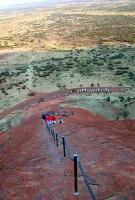

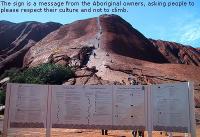
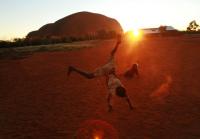
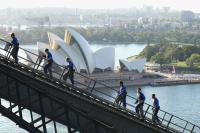
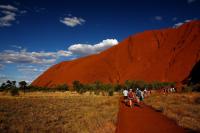


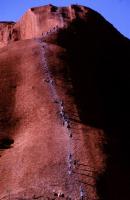
just one question:
why the fuck doesn't one single person of the tribes have the idea to climb uluru just once with a motorized angle grinder and enough gasoline and cutting disks and start to remove the climbing help chain'n'stakes from top to bottom? best time would be, when there are lots of tourists. this would at least prevent a third up to half of the stupid to get up there.
and, btw : why on erarth did the tribes lease uluru back to the national park when they got it back?
action is better than complaining.
Just too weak to resist
They would not have got it back if they had not swallowed the lousy dictate. See http://learnline.cdu.edu.au/tourism/uluru/background/history/anangu.html. The usual rape of Aboriginal people by the invader society.
As to cutting the chain, someone did for a while and was feted as a hero: http://www.bing.com/search?q=cut+uluru+chain&src=IE-TopResult&FORM=IETR02&conversationid=